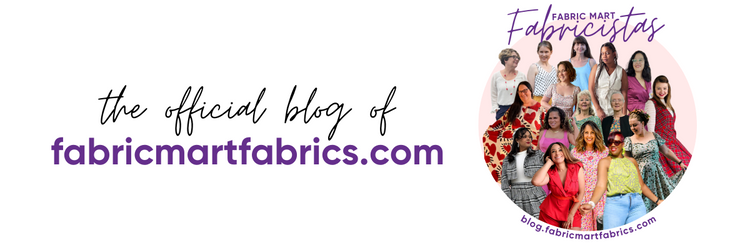Are you ready to begin? I'm really excited about the Pretty Peplum Top Sew Along and seeing what questions you have and how your tops turn out in the end! We will be covering each step in this sew along as well as modifications, tips and other ideas for this peplum top from Pamela's Patterns. Pamela will also be on hand to answer your fit questions!
So let's get started. Some of you may already have this step taken care of, but there may be some of you that need some guidance. This pattern calls for a good quality knit fabric. Pamela also gives a tip for making sure the fabric snaps back into place. This means it has to have stretch. When someone says "stretch" knit what does that mean? Mostly all knits stretch, but do they recover back to their original state? If they do, then they have spandex, lycra or elastine. (Lycra is a product and trademark by Dupont Company.) There is no technical difference between spandex, lycra or elastine. If you want to learn more about that, here is a good article about that.
Here's an example of a knit without spandex/lycra:
Notice that I always have the left side lined up with 19" mark. As you can see with this particular fabric, the fabric was stretched and left go. It "grew" about an inch and did not recover. These fabrics usually will come back to position after being washed.
Notice that I always have the left side lined up with 19" mark. As you can see with this particular fabric, the fabric was stretched and left go. It "grew" about an inch and did not recover. These fabrics usually will come back to position after being washed.
Here's an example of a knit with spandex or lycra:
Here you can see that the fabric was stretched but that the before and after photos measure the same. That means this fabric would be suitable for this pattern because it has good stretch recovery and will not grow as much as a 100% cotton/poly/rayon/etc. knit.
I would recommend any light or medium weight knit for this pattern. I would not go much heavier than a ponte knit with some drape, because something that does not drape well will not create a nice, smoothing peplum. A stiff knit will create a peplum that stands out more like a tutu!
I used a few different kinds of knits for the various peplum tops I created. I used an ITY knit, a jacquard double knit and a ponte knit.
An ITY knit is a lightweight jersey-like knit that is good for tops, skirts and dresses. I use ITY knit all the time and it comes in a lot of pretty prints and solids. I always think the photos showing the twist really help me visualize what the fabric would feel like. LIghtweight knits usually have small folds and that is evident in this photo. See all ITY knits we carry HERE.
A ponte knit, jacquard double knit or any other double knit with stretch would also be good. This type of knit is a light-medium weight so it will have a little more body than any ITY or jersey knit. Again, look at the folds. If they are big folds, this may be too stiff for this pattern. See all Ponte knits HERE.
 |
The white fabric is a stiffer ponte than the tan fabric. You can tell this because of the flowiness of the folds in the tan versus the white. The white folds are much more structured. Of course if you want a structured peplum top, this could work for you!
Other knits that could be used are: rayon or cotton jersey knits, cotton interlock. I would not recommend a really lightweight or sheer jersey knit because they usually do not have a nice stretch and recovery factor. While I'm not sure I would make this pattern from a lace or mesh, it probably could be done! But I would recommend finding a lace or mesh with ample stretch. See our entire knit collection HERE.
So now go pick 2 1/4 yards of your choice fabric and get it washed! I ALWAYS pre-wash my fabric before cutting. I actually wash the fabric before it even makes it to my sewing room, so I always know that any fabric in my sewing room can be used. No guesswork! Then I'll see you next Friday with our first step...cutting out the pattern!
So now go pick 2 1/4 yards of your choice fabric and get it washed! I ALWAYS pre-wash my fabric before cutting. I actually wash the fabric before it even makes it to my sewing room, so I always know that any fabric in my sewing room can be used. No guesswork! Then I'll see you next Friday with our first step...cutting out the pattern!











Nice
ReplyDeleteI liked it so much
I will visit here again